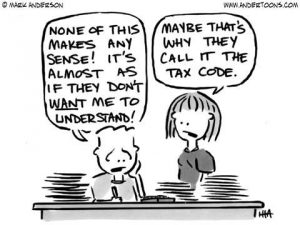

Unlike what this comic says, filing your own taxes is not the most difficult job in the world. Sure, it is complex, and there is a lot of jargon involved, but isn't it better to know how much and why you are paying to the government instead of blindly trusting someone else you have paid to do it?
In this article, we are going to teach you how to file your own tax returns. However, before you can go ahead with it, there are two articles you need to have a look at.
- Salary Slip Explained - Your salary slips has a lot of components, some of which might leave you confused. Learn about your salary slip here.
- Form 16 - This is one of the most important documents you will need while filling your tax return yourself. This article explains the elements of the form and how to understand it.
Having read these articles, you will be able to understand this article much better.
The tax system in India states that tax returns must be filed at the end of every financial year by individuals who earn more than INR 2,50,000 every year. Tax returns can be filed either manually or online. Of course, these days, the latter method is opted by most people.
Most businesses employ professionals to do their taxes for them, however, if you're a salaried individual, it will be more convenient for you to file your tax return on your own.
This article will guide you on how to do the same.
Ideally, you should get your Form 16 from your employer. However, if you don't have it, you should take the following steps.
- Collecting salary payslips
Collect your salary payslips of the entire financial year. If you have changed jobs midway, make sure you don't lose out on any payslips from your previous employer.
2. Verify the TDS by referring to the Form 26AS
Your employer deducts your TDS, but before proceeding with filing the returns, it is advisable to confirm the amount by referring to Form 26AS. You can refer to it by visting the
Income tax India e-filing website and finding the Form 26AS. Log in to your account using your PAN card details, and obtain the form.
This form tells you how much tax has been deducted on your behalf by your employer. If there are any discrepancies in the TDS deducted, inform your employer and get it corrected.
3. Obtain HRA benefit.
Most employers get HRA (House Rent Allowance) benefit. You should submit your rent receipts to your employer to obtain this benefit, and if you haven't already, you should do it while filing the returns.
4. Claiming other deductions
Keep your investment documents handy, and claim all the deductions under sections 80C (Life Insurance, Employee Provident Fund, Public Provident Fund etc.), 80D (Medical insurance premium), 80E (Interest on education loan) etc.
5. Account for other sources of income
If you are earning from sources other than your salary, say, if you are giving your house on rent, or earning some money by freelancing, interest through your Fixed Deposit, you should include it under your taxable income as "income from other sources".
6. Pay the difference
Compare the tax paid on your behalf by referring to the Form 26AS with the amount of tax payable by you according to the tax slab under which you fall. You can refer to the tax slabs at
this link.
If there is a difference between the both, and you are required to pay more tax, do it online right away.
On the other hand, if you have been charged more TDS than payable by you, you will get a refund for the same by filing your taxes online.
After you have ensured that you have paid the tax payable by you, you can go on to file your tax returns.
We shall cover that in the next part of this article. Stay tuned to this space for the same.




